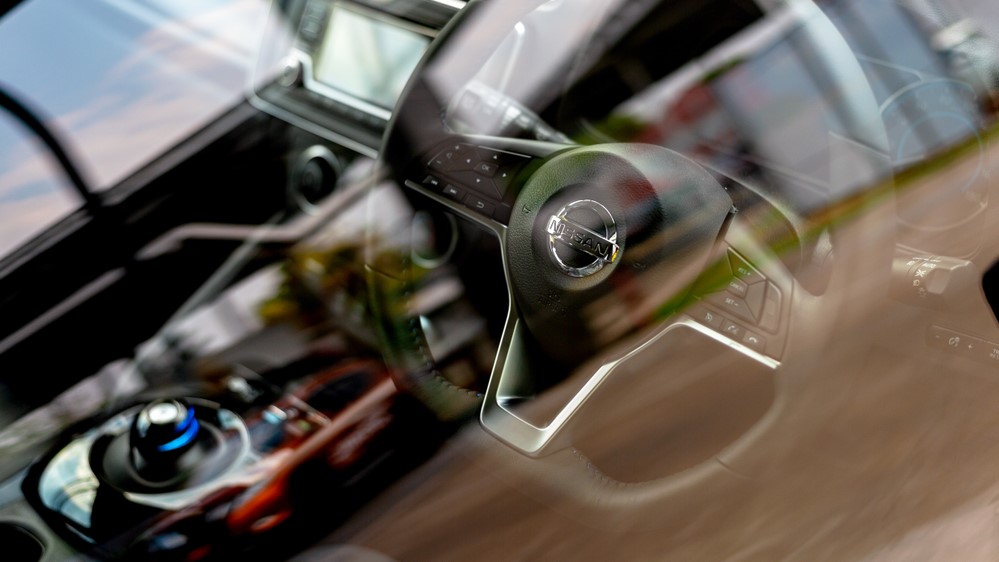How the new Nissan Leaf helped me conquer my fear of driving

I’m not a confident driver, so I almost turned down the opportunity to test the new Nissan Leaf for three days – but I’m very glad I didn’t.
I learned to drive when I was 19 on the distinctly un-mean streets of Milton Keynes – a town 50 miles from London, known for its 130 roundabouts (traffic circles, if you’re from the US) and utterly straight, flat roads. Predictable and easy – nothing like the rest of the UK, where city centers are single-track tangles of tarmac, lined with parked cars and connected by winding country lanes with a mad sounding speed limit of 60mph.
Before taking the Leaf on the road, I booked myself two refresher lessons to make sure all knowledge of driving hadn’t somehow dribbled out of my ears in the 10 years since I passed my test. The instructor’s car was a Toyota Prius – a hybrid to bridge the gap between the petrol-fuelled Nissan Micra I first learned in, and the shiny new Leaf.
Thankfully, everything was still there, even if a little rusty. The car didn’t roll five times and burst into flames. There were no fatalities. I was ready.
A helping hand (or foot)
The Leaf is a nippy, agile little thing or so it felt to me, my point of reference being a Nissan Micra. It easily handled the rather steep, winding path down to the beach I chose to visit on our first day together – not in Bristol or Milton Keynes, but the island of Harris and Lewis in the Outer Hebrides.
One of the Leaf’s key selling points is the e-Pedal, which applies the brakes automatically when you lift your foot off the accelerator. In theory, this allows you to drive with just one pedal.

It took some getting used to; it often hit the anchors a little more forcefully than I would myself, and prevented the 'creep' that makes automatics inch forward when neither brake nor accelerator are pressed. I did become accustomed to it though, and I can see it working well for stop-start city driving.
Sign up for breaking news, reviews, opinion, top tech deals, and more.
The ProPILOT parking was more impressive still, and felt like a glimpse of (automated) things to come. Line the car up with a space, make sure the correct parking mode is selected using the touchscreen (parallel park, or forwards or reverse into a bay), check that the coast is clear, then hold the ProPilot button and the car will take over, turning the wheel and applying the accelerator and brakes for you.
The car's multiple sensors watch out for obstacles, and releasing the switch or touching any of the controls yourself will return the car to your control if you need to take over. It goes without saying that you need to keep
ProPILOT works best with clearly marked bays, and you must take care to select the right mode before letting it take control. On my first attempt, in a quiet supermarket car park, I selected parallel parking by mistake and ended up perpendicular, neatly straddling two spaces. I don’t think anyone saw me, thankfully, and it worked perfectly on a later attempt.

It's worth noting that, when reversing into a space using ProPILOT, the car always performs a two-point maneuver rather than turning 90 degrees. It means the car has more room to move, and can more easily judge angle and distance, but fellow drivers might get impatient.
ProPILOT doesn’t always detect every empty bay either, resulting in you crawling along and holding up traffic, but with a little experience you’ll learn how to position the car so it identifies available spaces.
When you're doing the hard work yourself, the rear camera makes life much easier, as does the Intelligent Around View Monitor, which shows a bird's-eye view of the car and its surroundings. Better yet, it also shows the car's trajectory based on the position of the steering, making it easier to judge maneuvers.
On the right track
Having learned on the enormous streets of Milton Keynes – a town built for the car – I found the relatively narrow Hebridean roads a little daunting, and was terrified of straying too close to the center line and clipping oncoming traffic.
With hindsight, I should have given the Leaf’s lane departure warning a shot. This system warns you if there’s a risk of you leaving the traveling lane unintentionally. It wouldn’t improve my driving, but could have served as a set of training wheels, helping me get a better sense of the car’s position on the road relative to my own until I didn’t need it.
Charging is amazingly simple – no tougher than charging a phone – and the need to wait a while for its battery to charge means you get a pleasant break from focusing on the road.
I also picked my destinations carefully – a beach, a park, an ancient stone circle, somewhere to take a walk and get some fresh air. Even with the Leaf lending a hand, I still arrived pretty anxious – but I did get there.


Cat is TechRadar's Homes Editor specializing in kitchen appliances and smart home technology. She's been a tech journalist for 15 years, having worked on print magazines including PC Plus and PC Format, and is a Speciality Coffee Association (SCA) certified barista. Whether you want to invest in some smart lights or pick up a new espresso machine, she's the right person to help.